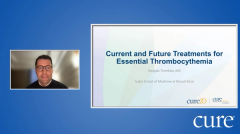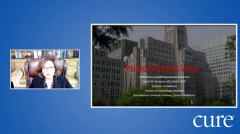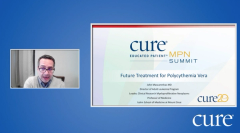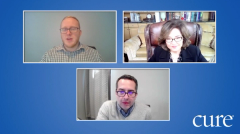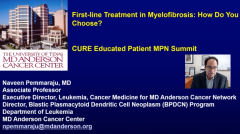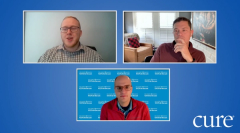
Educated Patient® MPN Summit Myelofibrosis Panel: November 19, 2022
Watch Dr. Aaron Gerds and Dr. Andrew Kuykendall answer questions about myelofibrosis during the CURE Educated Patient MPN Summit.
Episodes in this series

This panel was moderated by Ryan McDonald, and featured Dr. Aaron Gerds, from Cleveland Clinic, and Dr. Andrew Kuykendall, from Moffitt Cancer Center, who answered questions about myelofibrosis (MF).
McDonald: So Dr. Kuykendall showed several treatments options (for the) second line for myelofibrosis. (If a patient receives) one second-line (treatment with) drug x, but (their) disease fails to respond, can (they) still get those other second-line treatments?
Gerds: I think that's a fantastic question. And I'll try to do it justice. … So you know, if you have a second-line therapy (it) doesn't preclude you from getting us to another second-line therapy, which I guess in that sense would be the third-line therapy. But they're usually not mutually exclusive. If you have a number of different options, you can have the reassurance that if you choose one option at the time, it's not going to preclude you from using the other options in the future.
McDonald: Well, Kuykendall, you presented data showing at one point that second-line treatment may induce greater benefits in certain patients. So I'm going to ask a question that some patients may wonder, is this being studied to move this in the first-line (setting)? And if so, what are those results showing?
Kuykendall: Yeah, I mean, I think it's a little bit artificial to think about these as first-line, second-line and third-line therapy in general. I think most of that comes into play that a lot of patients are on therapies for long periods of time, and they're already on a therapy right now. So their question is, what happens after this? (Inrebic [fedratinib]), while we think about it as a second-line therapy in a lot of patients is agnostic to line of therapy. It's definitely been studied in the frontline and has benefit there. No one's really compared to fedratinib to (Jakafi [ruxolitinib]) head-to-head and that's not going to happen. And there's certainly reasons why we feel comfortable with ruxolitinib over fedratinib in most patients. Even though some of these have or may have on their label, as they get approved, they have kind of caveats exclude just their second line or two. But I don't think that that's necessarily how we view that in the field. I think we were identifying what's the best treatment for the patient sitting in front of me. And in many cases, that's ruxolitinib.
But it may be that while you're on the treatment with ruxolitinib, and if something happens, something changes, or your numbers change, where we no longer think that's the best therapy for you. And in that case, we are moving to second-line therapy, but it's not because necessarily the ruxolitinib has failed. Usually, we're just realizing that the patient we're treating has different needs right now. And we need to optimize those strategies. And so we are always looking at what's going to be the better frontline. And I think the more relevant question now is, there's phase 3 clinical trials that are saying that is a single agent JAK inhibitor, the best initial strategy, right? Or can we do better than that? Our current state of affairs is that we're trying to improve spleen size and symptoms, and the vast majority of these patients, we would love to modify the underlying disease, we'd love to prevent progression of the disease, we'd love to prevent this from going down. Well, we'd love to cure it. But the question is, how do we do that? And it's likely not going to be a single agent approach. And so that's what we're trying to see is if combination therapies upfront hitting the disease harder earlier, matter for long term outcomes.
McDonald: Okay, a follow-up (question). We've talked about it just now. People are always like, what's next? And there's always that anxiety and that concern of this isn't going to work. What's next? So how do you reassure patients that say, “Listen, we'll figure it out as we go along. I don't want you stressing and concern yourself. Because we don't know what's going to happen.”
Gerds: I think some of it's a product of that discussion where we talked about lines of therapy, which is something kind of erroneously borrowed from solid tumor oncology, right. So have a tumor, you get chemo, it shrinks. The tumor eventually goes back and get chemo again. And it's a very succinct thing, whereas Dr. Kuykendall mentioned with myelofibrosis and MPNs in general work. It's kind of a more widening, waving type of thing where we're just addressing the needs that come up immediately. So I think that that adds to a lot of the anxiety. You know, “Oh, my goodness, I'm on second-line therapy. I must be bad.” No, it's just we chose the first drug or first treatment (and it) just didn't work as well as we wanted it to. And we should try to optimize things as we can. I think one of the other key pieces for a lot of people with myelofibrosis, you know, the course can be long. And there's time that we may develop new therapies. And I think that's encouraging if you got a longer time horizon there, there may be new things by the time that you need them. Dr. Kuykendall also pointed out, I mean, stuff is rapidly moving along and we’re very excited to see all these new therapies potentially come in the next year to three years. So it's moving quite quickly.
Kuykendall: I agree. I think one of the ways to reassure patients that I employ is just to reassure them that we're not committing you to a treatment for the rest of your life. This is a an evolving process where I think one of the things we've learned with ruxolitinib is rarely does it completely stop working. Right, it often is still providing some benefit. But unfortunately, the disease changes over time. And maybe that benefit is not as evident as it was early on in the disease. But that's the reason we see you every three months, or every two months, or every six months, or whatever it is, is because every time we see you, our job is to sit there and evaluate the disease, evaluate the therapy, evaluate how you feel, and determine whether or not this is still the path we want to go down.
And honestly, I think with patients where I have, you know that they have some concerns or side opinions or something, I'm often talking to them and say, “Hey, here are the three other options we have down the road if your disease does X, Y, and Z.” Right. So that's, I think, reassuring to know that there are other options.
We mentioned clinical trials that are coming, clinical trials that are open elsewhere, that they could consider the idea of transplant, “oh, there's new agents going to be approved in X amount of time.” That could be a consideration. And I think when patients hear that, I mean, we never talked about this with blood pressure, right. So like, when you get started on Lisinopril people are like, well, what if this stops working? Right? What else can I possibly do for my blood pressure, there's like 50 blood pressure medications, we will switch to another one. And so I think in some ways, it's a better situation and a better conversation to have now than it was five years ago, when we didn't have the proliferation of other options.
McDonald: So one of the words you mentioned that I'll see if Dr. Gerds wants to tackle this, you use the word transplant. One patient is curious, is there anything that would limit me from being a candidate for that? And if so, what can I do to be a candidate? Or? I'm just out of luck?
Gerds: Yeah. Well, that's a great question. And as a self-described, a recovering transplanter, I'll say, you know, we really look at two different things. We look at disease and where the disease is. Is it under control? Is it not under control? And do we think that's going to impact the outcomes of transplant? And the other thing was, we look at the individual. And you know, age is not the first thing on the list. You know, people are like, “Well, I'm 68. I'm too old for a transplant.” And that's not necessarily right. It's more about how fit you are as an individual. Do you also have heart disease? How's your liver function? What are your lungs doing right now? And in that kind of global picture of how healthy an individual is, in the background of what is the disease doing? Is it under good control? Do we have the spleen in a decent place with the JAK inhibitor or is the spleen ginormous? Are the blasts slow or the blasts very high in this accelerated or blast-phase disease? And so depending on how those two things look, that determines someone's candidacy.
McDonald: So Dr. Kuykendall, we talked about second line and beyond and one of the questions that came in from an audience member, which I think is actually a valid question is, there's so many different second-line options, right, all showing similarly good results. Why is that? And is it just because, hey, there's so much out there, and they're all working well? What's behind that?
Kuykendall: Yeah, it seems like when a drug works, it meets about a 30% threshold. We often say those 30% response or 35%. And some of that speaks to the heterogeneity of this disease. I think, unfortunately, myelofibrosis is, fortunately or unfortunately, it's not the same from person to person. So you're not going to come up with this therapy that gets a 90% to 100% response rate. I mean, that'd be great. Maybe Aaron's working on that. So he hasn't told me about it yet. So we'll see.
But, you know, obviously, that's the goal. Part of us though, thinks if we identify correct patients better, if you really optimize the population you're treating, those response rates would be higher. The way trials are written. Now, you want to be very inclusive. When you're studying a drug. You don't want to limit patients from what opportunities they could test out in clinical trials. So you want to be as inclusive as possible. But then we're going to use that data. Let's say we get approvals for five, six agents, we're going to use that data to then go in and mine the data and see who is the most likely to respond. People that had this specific kind of makeup had a 60% response rate with this agent, and maybe, you know, 20% with this agent, so, we're going to start to go in and hopefully be able to individualize therapies. The reason why we see those responses, because these are active agents. And we're testing a broad array of disease. And so, you know, the goal is to get these things. So they're available for us to use, and then then we need to figure out how best to use them.
McDonald: Okay. Dr. Gerds, I'm going to turn back over to you. We had a question come in, which we kind of talked about a little bit earlier. But for those who may have joined us a little late, I talked about percentage of patients with PV or ET progressing to MF, can you touch upon that like how the progression works and whether or not certain aspects of that progression go into treatment decisions?
Gerds: Yeah. So I think the absolutely happy to address that. And I think the simplest thing, the way to think about it is, you know, in terms of the proportions of patients during the PV and ET talks, we spent all this time talking about thrombosis risk, because that's the most prevalent complication. We weren't talking in large parts about disease progression, because that's less common. So just to kind of put that within a context. So it's a less common event, but certainly does happen.
McDonald: Since you said it is rare, does any of that play a role into treatment decisions? Or is it just going to go as the disease goes?
Gerds: Yeah, I mean, I think the big thing is that we want to do at a minimum is not provoke progression. So there's plenty of data from the polycythemia vera study group on showing that certain agents we used to treat PV and ET do increase the risk of progression. And we talked about things like busulfan, which is a DNA damaging drug and alkylating agent. And we know that that's associated with increased risk of developing acute leukemia in patients treated with it for MPNS. Likewise, a macrolide is associated, at least in one randomized clinical trial with an increased risk of progression to myelofibrosis.
And so obviously, we want to try to avoid some of those agents use them. And we have to, of course, really try to think about are there alternatives that we don't provoke progression? In terms of reducing the risk of progressiom? We touched upon it earlier. I know, there are some drugs that we think may do that. You know, the one that's in debate that we talked about often now, are interferons as a class. You know, there's a retrospective study from the group in New York City that show that yeah, maybe interferon treatments associated with a better myelofibrosis-free survival. And we talk about allele burden is going down. And maybe that's a clue. Doug Tremblay talked about (a drug) and how it altered allele burdens as well, and maybe some more aggressive clones and that might prevent progression. You know, I don't think we have anything that is absolutely conclusive where we all can stand up at the podium at a big fancy meeting, say yes, this prevents progression. Certainly, there are lots of clues and hints. And we hope that a lot of these new therapies like Dr. Kuykendall presented will help delay progression, not only in more advanced disease, but maybe even an earlier disease if we move it up that far. So while we may not have a lot that delays progression, necessarily, we definitely want to make sure that we're not doing anything to hasten it.
McDonald: And lastly, Dr. Kuykendall, CURE is turning 20 this year, and we're looking at the space as a whole with myelofibrosis. Looking ahead down the road. What are some of the main things that still need to get done?
Kuykendall: I mean, I think certainly we could talk about disease modifying therapy. That's always the easy answer there. I think my biggest thing recently, and I think curious, helping for this standpoint, as our other groups is, I think, with more and more companies getting involved in myelofibrosis and more and more drugs that are being looked at, I think there's more of a focus on the disease. And I think one of the things I'm passionate about is getting patients to really truly understand their disease. And I think it's really frustrating when you see patients come into the clinic who have had the disease for 10 to 15 years but really have a complete misunderstanding of what's been gone going on. And I think that these programs, I think kind of getting the word out there that patients should really try to if they have questions either read about it, you know, access literature, see an MPN specialist, at least one time during the course of the disease to get as much of your quote many of your questions answered as possible and really feel like you have a good understanding and keep a dialogue if possible. with one of those specialists that kind of help guide the therapy as you get closer to home, because I think that that's very, very possible and feasible. You know, I think there's many different avenues virtual stuff has helped a lot with being able to access this and patients that aren't close to an academic center aren't in the state don't have the ability to travel. And so my goal over the next five to 10 years is really to create a very educated group of patients, who then are going to be much more trusting of physicians who want to then bring up the idea of clinical trials. And with that, like kind of network of physicians and patients and, and, and industry, I think we can kind of move this disease and the treatments for the disease forward much faster.
Transcription edited for clarity.
For more news on cancer updates, research and education, don’t forget to

